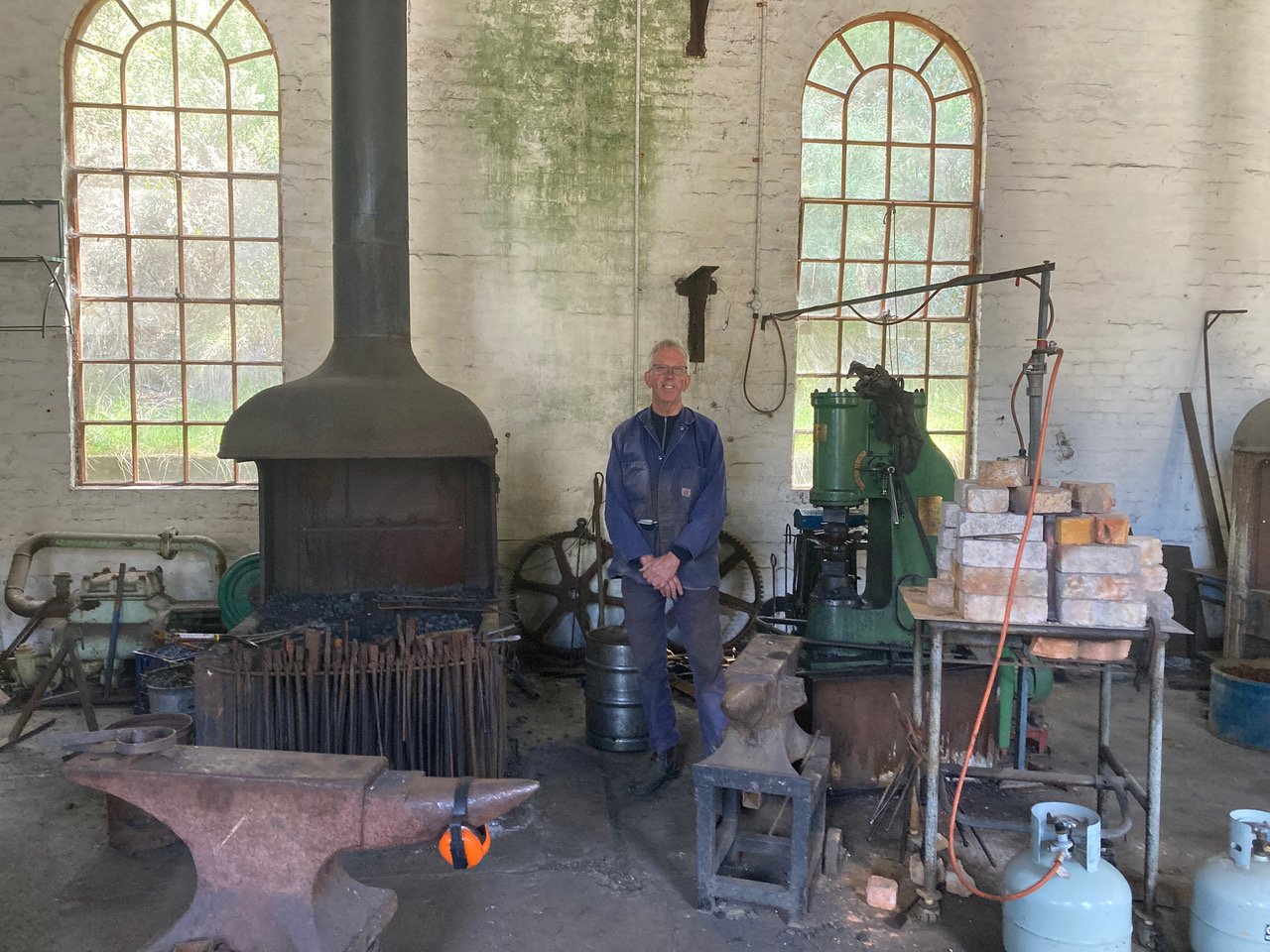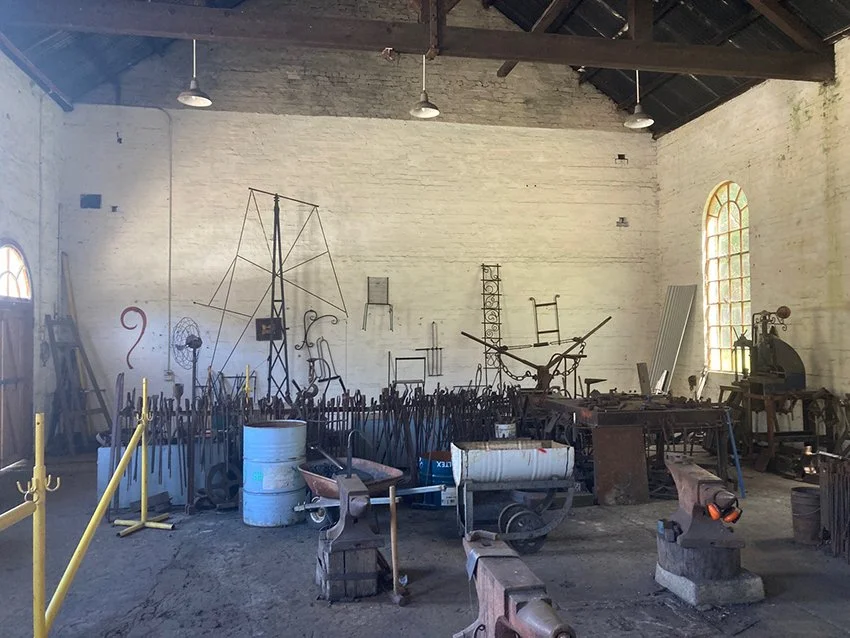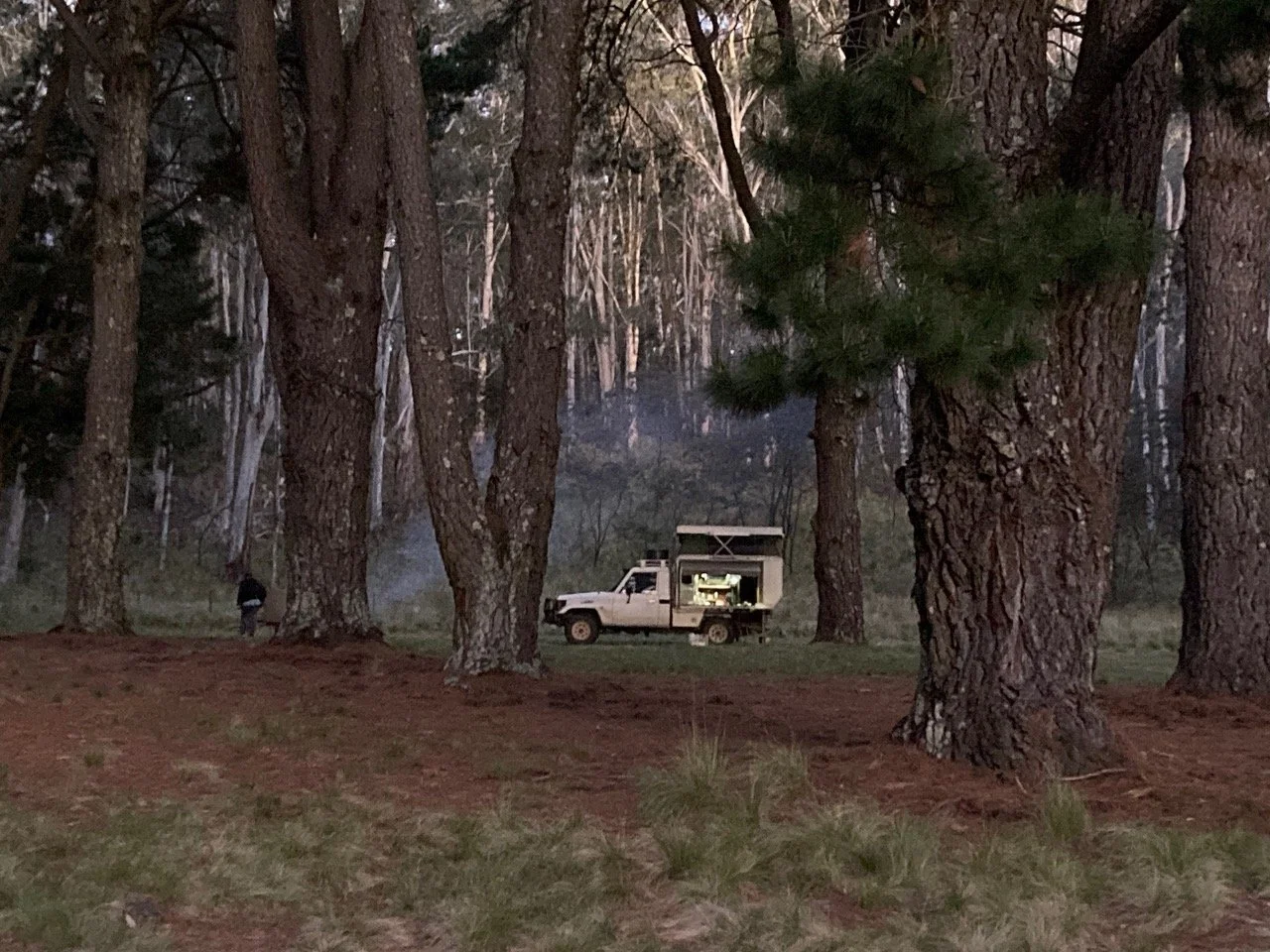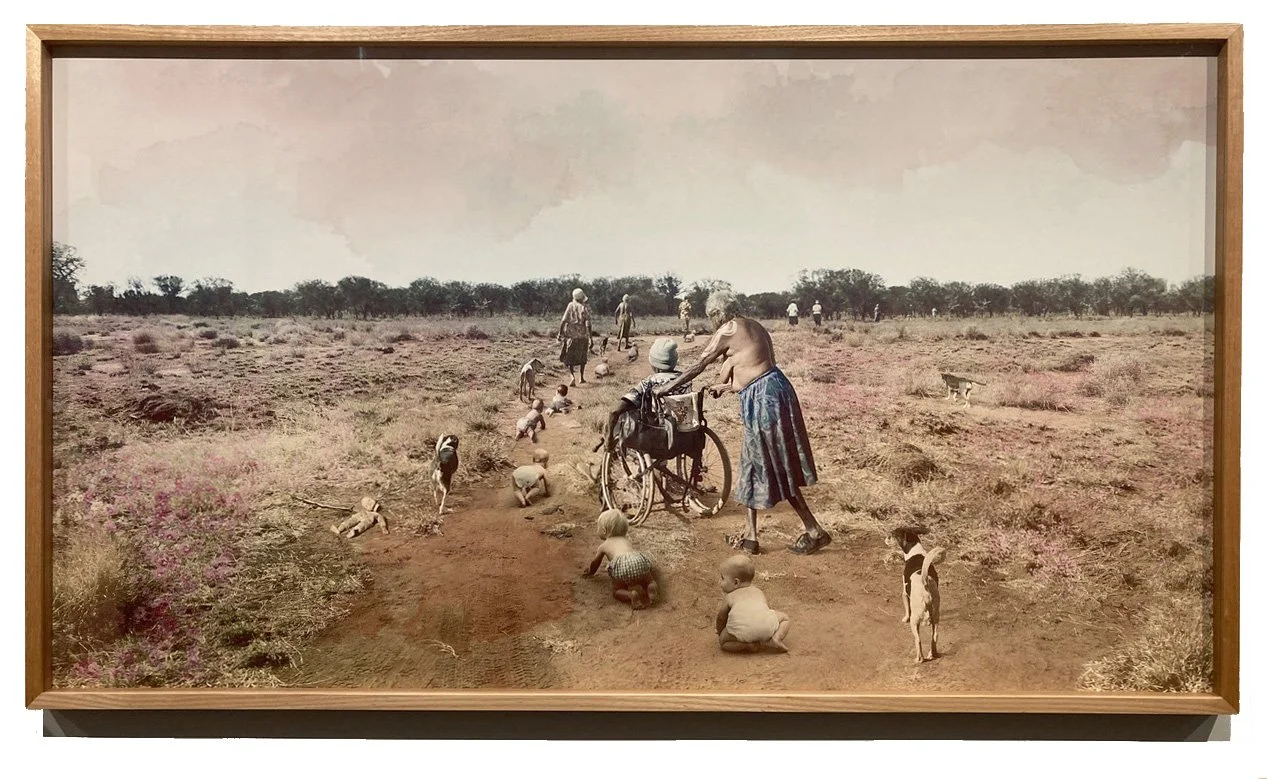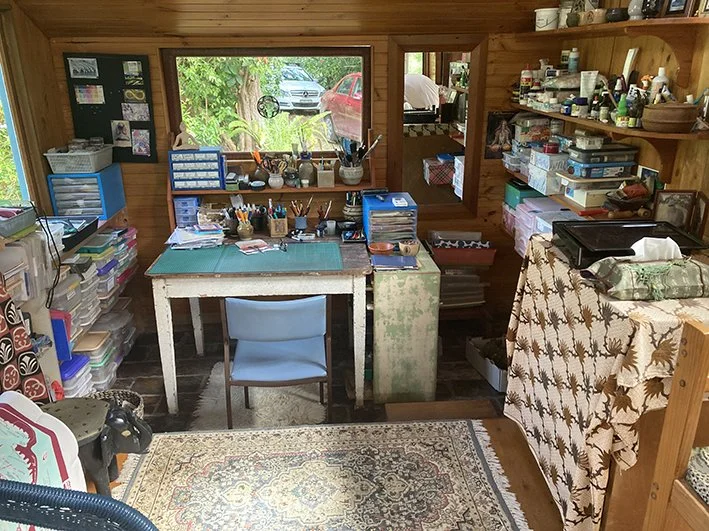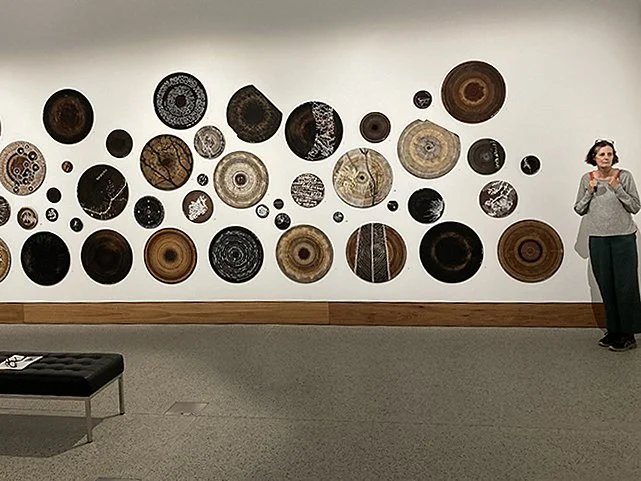Credits are often reserved for films … but, in refracting and reflecting upon a recent roadtrip through north-western NSW up into southern Queensland + back down the coast, I have a cast of spirited and generous folk – known & unknown – to thank. Our 15-day adventure sampled four remote campgrounds, eight galleries, six motels + a sprinkling of servos, op shops, pubs & food providores. As the mercury vacillated between 3 and 34 degrees there were chance encounters, long-delayed meet-ups, enriching exhibitions, welcoming hearths, stirring vistas, serendipitous conversations & crucial tyre-repair services. For help which importantly if inadvertently determined our route, my thanks go to Caroline @ Warrumbungles Shire Council … for getting back to me immediately and leaving two key road-condition updates for Coolah Tops on our message bank just before we left ... such green-light advice gold for city-slickers like us, who insist on going bush fully-laden in low-slung 2WDs!
Just over the mountains on our first morning we pull in for a chinwag with old-mate blacksmith-metalworker Phil Spark in Lithgow, proffering him a piece of Denise’s home-made cake for showing us around his astonishing workshop @ the Lithgow State Mine Museum.
Phil next to the forge in his Lithgow workshop, and (below) some of his hand-made tools & works in progress Pics Denise Corrigan
I routinely remember that Phil (born & raised in West Yorkshire) & I crossed paths in London c. 1983, when he built bicycles & I worked @ Bicycle Magazine, despite the fact that we first met a decade later in Glebe. And although I missed its (temporary) installation over the upper reaches of the Parramatta River in 2008, Phil’s magnificent, mischievous Shopping Trolley Arch never fails to ignite my suburban imaginary. In 2013 Phil created the Lithgow History Avenue – an array of 30 idiosycratic sculptures inspired by local social & industrial history – which you can follow and enjoy along Inch Street to this day. As we depart complaining about how cold our home studio in sub-tropical (!) Sydney has been this winter, Phil recommends that we investigate battery-powered heated jackets, innovative apparel currently all the rage in his perishingly-cold town.
After a short drive north-west up the Castlereagh Highway, next day we check out Royston Harpur: A Painter’s Painter @ Mudgee Arts Precinct, an elegant introduction to Harpur’s vital painting and life (1938–2023). Deeply informed by Japanese Ch’an (Zen) Buddhism, Harpur was a pivotal figure in the evolution of Australian post-WWII abstract painting, as a practitioner, gallerist and writer. He taught painting & art theory @ the National Art School in Sydney for 20 years, later retiring to Mudgee. Ex-Sydney College of the Arts confrères Brad Buckley & Helen Hyatt-Johnston helped bring the exhibition and its thoughtful catalogue to fruition, and Ann Finegan has written an interesting review. New to Harpur, I found myself beguiled not only by the dream-like fluidity of his imagery, but by the fact that he painted many of the works on show quite quickly outdoors ‘on the flat’, in bare feet. First moistening his meticulously-gessoed masonite boards, Harpur would apply paint by brush then move (& sometimes remove) parts of the image with a garden hose … randomness & chance allowing his forms ‘to discover what they wanted to be’. [Paul McGillick, p. 18 of catalogue]
Royston Harpur, The Mountain of Souls (detail), 2012 Image courtesy the Estate of Royston Harpur
Just under 100 kms (as a crow or cockatoo, even a king parrot might fly) north of Mudgee, on a high plateau straddling Wiradjuri & Kamilaroi Country, lies Coolah Tops National Park. Before it was gazetted in 1996 this lesser-known, unusually peaceful Park was a state forestry preserve where ironbark was once ‘won’ and milled (for railway sleepers), and pine plantations unsuccessfully trialled.
Vin @ The Pines campground, Coolah Tops National Park Pic Denise Corrigan
The camaraderie of remote camping is on quiet display @ The Pines campground one particularly chilly evening when fellow off-grid camper Vin, a wiry 70-something farmer from Tamworth … advising ‘don’t be cold’, slices up some thick boughs of fallen radiata-pine for our fire ring with his petite electric chainsaw. Next morning we’re grateful, too, to his wife Heather for sharing elusive phone-reception advice which enables us to drive to nearby Bundella Lookout (within the Park) to confirm, with a welcome ping, that our musician son Luca has touched down safely in Warsaw! As I swing my G10 around to frame the stellar view north from this special spot high on the escarpment I catch, at first from the corner of my eye, intriguing evidence of earlier arborial co-dependency here on the Tops.
Scarred tree @ Bundella Lookout, Coolah Tops National Park
In the glove box is Kate Grenvile’s latest book Unsettled (2025), which proves salutary reading as we leave Coolah Tops after a rather terrifying electrical storm on our last evening in the campground, and head north through gorgeous Pandora’s Pass across the Liverpool Plain (where at one point our approach disturbs seven magnificent wedge-tailed eagles dining on road-kill), bound for Tamworth. Grenville’s journey north-west from Wiseman’s Ferry (the locus of her seminal earlier work The Secret River) takes her by road and on foot through Country into which her latter ancestry percolated in the 19th century, veins & arteries we ourselves are about to travel, and her route is swathed often in thoughtful self-reflection:
Conversations and consultations are important. But they can also be a trespass on someone else’s pain. At times, too, they can feel close to asking for an unearned reassurance or even forgiveness. [p. 28]
I’m interested in how even a well-meaning white person like myself tells that story in words that let the actuality go vague and passive. I’ve got that bit of knowledge, but it’s a weak little thing – old history, facts a person can rattle off – with no relation to real people in a real place. Sitting here on this warm rock listening to the leaves shifting above my head and feeling warm fragrant air coming up the hill, I’m thinking that bringing myself to the landscape was the right thing to do. There’s knowing things, but when you’re on the place, you can see how knowing doesn’t get you very far. [p. 49]
I know I can only feel that warm marveling because I’ve got my bottle of water and sandwich down there in the car. I stare out over the vastness, and the thing like fear that I’m feeling, and don’t quite want to admit to, is what it would be like to be here in this landscape all by myself, a small bag of warm blood and soft flesh. [p. 50]
New England Highway, Glen Innes
A couple of nights’ later – in Glen Innes – we eschew the Hereford Steakhouse at our motel and walk in to town to order a special-fried rice @ the Dragon Court Restaurant, where a most-welcoming maître-de takes our order. Due to a staff shortage, the restaurant is only doing take-away this evening, so we enjoy five unexpected and most lively minutes’ chat at the till. Our hostess, it transpires, has only recently re-located with her husband to Glen Innes … she’s of German/Aboriginal descent (‘their flags have the same colours, you know’) … and likes the idea of being half-way between Brisbane (where she & hubbie raised a family) and Forster (where her Biripi mob live). I tell her that we love the coast south of Booti Booti perhaps more dearly than anywhere else in the world, and that I swim with a fellow and his wife, a Biripi woman, at Dawn Fraser Baths in Balmain. But by then and before we’ve had time to introduce ourselves any more meaningfully, our rice is ready.
Peter & Eve’s place in Woodside, west of Tenterfield Image courtesy Google Maps
Our Xmas cards have found their way to Peter & Eve Sainsbury 24 km west of Tenterfield for years, but despite two postponed attempts, we have not. So it’s marvellous, finally, to darken their door. The couple, whom I’ve known since the early 1980s @ the British Film Institute, sold up in Lilyfield earlier this century and went on (and off) road around Australia for five memorable years. They subsequently settled here off-grid on 40 acres in rural Woodside. Beyond the stresses of careers in film production & publishing, the pair today live more simply, surrounded by the natural world, and books. Peter, I’m reminded by his bio, worked with the iconoclastic British filmmaker Peter Greenaway on a number of his renowned features, and even had a part in The Falls – a film I’ve long adored. As well as a passion for remote camping (Peter & Eve recommend that next we sample Girraween National Park, just north of the border) & bird-watching, I discover that we share a high regard for the Australian writers Gerald Murnane & Alexis Wright, and for Thai film artist Apichatpong Weerasethakul (who’s remarkable recent film Memoria with Tilda Swinton was, I learn, produced by Simon Field, with whom Peter founded & co-edited the critically-engaged British film journal Afterimage, 55 years’ ago!).
Bald Rock Creek, Girraween National Park
Beyond the grey-nomad brigade, with whose motor-homes & wine times we have little truck, national parks these days are home also to many an interesting, often-loquacious free radical. By (and in) the lovely granite-brown creek/swimming hole just down from the well-appointed campground (bookings are via app + there are even flushing toilets) we meet not only Girraween’s unique reptile Bell’s turtle, but another long-time park habitué, an ex-youth-worker from Caloundra, who, it transpires, also has a son in a band – Speira – who’ve just released an album. Although there’s only one bar of phone reception, thanks to the wonder of technology we’re later able to sample some of their audiovisual work on the big (lap-top) screen from the comfort of our tiny tent, and despite the intermittent interruption of wattlebirds, wonga pigeons and a patrolling squabble of white-winged choughs, it’s not at all bad.
Next morning, with a heatwave brewing, we pack up camp early and head off towards Brisbane. In ‘Queensland’s coldest town’ Stanthorpe, the mercury is nudging 35 by midday. We do a lap of the longish main street and – seeking sanctuary beneath awnings & in the anodyne, quasi-religious coolth of aircon – a little desultory op-shopping at Vinnies. Later, although we have only half an hour at Ipswich Art Gallery before it closes and there’s a Mark Rothko (on loan from the NGA) to savour, Michael Cook’s series Enculturation strikes a major chord.
From Michael Cook’s series Enculturation (2022)
As the artist’s webpage tells us …
Babies from a variety of ethnic origins, accompanied by camp dogs, follow Aboriginal women down a dirt track into a flat dry landscape. They appear compelled to crawl after the women, imbuing the elders at the heart of Enculturation with an eerie sense of magnetism. Photographed on Country with senior women painted up for ceremony, the narrative traces a journey through the landscape under an opaque and nebulous sky. Children sit amongst the women as they absorb the nuances of Country. In this series Cook evokes the potential for Indigenous cultures, and their learnings over millennia, to shift the concerns of white society toward the balance and harmony integral to the heart of First Nations traditions.
In Brisbane we enjoy a welcome night in a bed, and catching up with old-family friend Wendy Downes at her apartment in Fortitude Valley. After a number of demanding but rewarding years as a town planner liaising with indigenous communities, farmers and government, Wendy re-trained, studying affinage (the art of ageing cheese) in France. Fuelled by a belief that small-scale farmers, including dairy farmers, should be able to earn a living, she founded The Cheeseboard, a cheese shop and ‘finishing cave’ in Albion specialising in cheeses from independent producers across Australia. In 2023 Wendy was profiled on C9’s My Way … the five-minute video is an interesting watch.
Wendy @ The Cheeseboard, in the Brisbane suburb of Albion pic courtesy C9
Archie Moore, (detail) kith and kin, 2025 Image courtesy of the artist, The Commercial & GOMA
Next morning we head to GOMA to see kith and kin, Archie Moore’s monumental, hand-chalked and speculatively-traced 65,000 year-genealogy. A paen to blood (the artist has Indigenous, British & Scots heritage) and to family, including kinship with the natural world, the work is also a memorial to the unspeakable trauma and pain inflicted upon recent generations of Indigenous peoples in Australia. It urges us to attend to, learn about & care for the precious, so-easily-erasable ‘everywhen’ of which we all form part. Turns out Archie and Wendy are old friends. The bus to the always-impressive Gallery and a relaxing ferry-ride back down the river (thank you Qld) cost us 50 cents/trip! But after an uncomfortable brush with an overly-lavish designer-shopping precinct on the walk home, we’re pleased enough to be exiting Brisvegas after a nourishing 24 hours, skedaddling south for a cuppa and a chat with Wendy’s mum Barbara, just over the border.
_
Archie Moore’s work premiered + was awarded the ‘Golden Lion’ at last year’s Venice Biennale. The GOMA installation is on until October 2026.
Curator Ellie Buttrose backgrounds kith and kin in this fine essay.
‘Murwillumbah’, I’ve learnt only recently, is a Bundjalung word meaning ‘camping place’ or ‘place of many possums’. For decades prior it had remained for me a magical Anglo construct which fused memories of a seminal 1974 surfari with an old school-friend (on his Ps in his mum’s Morris Marina) and a rather fetching Federal match-box top I’d collected as a child, full of primary colours, primary industries & introduced species. I knew too that my Dundas next-door-neighbour Richard Downes (a conscientious objector to the war in Vietnam & USyd architecture student) had built a house up there in the hinterland with his (then) partner Barbara and her small daughter Wendy. We’d visited Barbara with our two young boys in our green VC Valiant on a stinking hot December day in the late 1990s. Our eldest son Aladdin still remembers that when he asked about going to the toot, Barbara (pointing out the back door to a halcyon sward of grass behind the house) handed him a spade.
Today, having plied her craft as a much-loved local music teacher, print-maker and mother for over 50 years, Barbara, aged 82, still lives in her magical forest home ‘Viridian’ @ Urliup, 11 km from Murwillumbah. Although we’ve remained in contact via (often delicately-illustrated, hand-printed, stamped & stitched) snail mail down the years, it’s a real treat to visit her again, and to immerse ourselves briefly in a deep bend of her pristine creek after more than a quarter of a century.
Barbara Downes with two of her prints + (below) her studio @ home in Urliup Pics Denise Corrigan
A first audience with Lismore-born Margaret Olley (1923-2011), as we walked back over Tweed River bridge from Jakes Tyres in South Murwillumbah one sticky morning … the portrait is part of a mural on the underpass painted by the community and local artists.
Although I was once a finalist in its Olive Cotton Award (for photographic portraiture) I hadn’t realised how much the Tweed Regional Gallery had evolved since first we visited it in Murwillumbah late last century. The new site, on a rise a few km out of town with a glorious view to the river, was gifted by (ex-local Member & deputy PM) Doug Anthony and his wife Margot. The Gallery now incorporates the Margaret Olley Art Centre (featuring several faithfully-reconstructed rooms transported from the painter’s Paddington home studio). Its scenic café is just the place to rest and refresh!
The café @ Tweed Regional Gallery overlooking the Tweed River
Alex Frayne’s remarkable Holbein-esque photographic portrait of Larrakia-man, artist, poet and dancer Joshua Campton … a memorable stand-out in this year’s Olive Cotton Award Image courtesy the artist & Tweed Regional Gallery
Jacaranda Festival, Grafton Pic Denise Corrigan
In Grafton we’re grateful to Janita @ Wykes Tyrepower, who gets to the bottom of a persistent slow leak in our rear tyre (a nail) which we’d worried about for a couple of hours in heavy freeway traffic out of Brisbane, had ‘sorted’ in Murwillumbah, then been plagued by again soon after. Her calm & expert workshop runs tests then conjures a new tyre for our old Mercedes in under half an hour, enabling us to scoot to the rather lovely Grafton Regional Gallery + encounter the town’s curiously-thalidomide Jacaranda Festival Kewpie-doll mascot … all before Wykes closes for the weekend @ 11 am on Saturday.
Julie Cane, Tea? 1940s Tea and Biscuits, 2024 Image courtesy the artist & Yarilla Arts and Museum
Brisbane painter Julie Cane’s powerfully simple oil-on-linen Tea? 1940s Tea and Biscuits (2024) - which we both love - is on show as part of STILL: National Still Life Award 2025 @ Yarilla Arts and Museum in Coffs Harbour. The artist’s Tea? series reflects upon the power of emotional connection, social ritual & the enduring human need for face-to-face conversations in an increasingly-virtual age.
Alexandra Byrne, Measuring Trees, 2025
In an adjoining gallery is Nambucca Heads-based Alexandra Byrne’s warlike array of augmented floor-sanding discs … ‘meditations’ variously inscribed & painted to explore the complex tensions between custodianship, silviculture, ‘lifestyle’ & energy consumption, nature conservation & forestry. Many of the discs, redolent of tree stumps seen from above (a bird’s or a koala’s-eye view?) remind me that only last month the NSW Labor government gazetted its long-promised Great Koala National Park across tracts of the mid-north coast, through which we are driving. Hoorah!
Denise on Goolawah Beach, nr Racecourse campground
As our illustrated road-trip draws to a close, I would like finally to thank Luke, a ranger @ Goolawah National Park & Limeburners Creek NP south of Crescent Head, whose good-natured commitment, local nous & advice helped make our last couple of nights ‘under nylon’, by beaches treasured since I was a teenager, so memorable. At Racecourse campground it was quite wondrous to fall gently to sleep soothed by the deep oceanic roar beyond its low dune, safe in the knowledge that special places like these, despite increased visitation and park maintenance demands, are being managed, loved and cared for in a spirit not dissimilar to past millennia. Once we can all agree that time is a cyclical continuum rather than a linear progression (i.e. ‘yesterday’, ‘today’ & ‘tomorrow’ are interconnected & co-exist), it might even be said that the Park’s nicely-designed contextual panels, handily located between our tent & the ablutions, are very nearly on song …
‘Goolawah’ means ‘yesterday’ in the Dunghutti language. The land is significant to local Aboriginal people, and their word for it is appropriate. Goolawah is exactly like yesterday – untouched by the footprint of development. This is what draws back visitors year after year.
These beaches are secluded and pure, bounded by exquisite native plant life rather than carparks or cafés.
